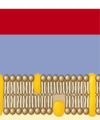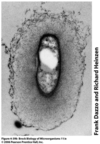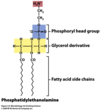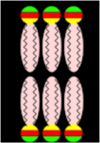Chapter 3 Molecular basics of Life Flashcards
(98 cards)
What are the parts of a Gram Negative microbial cell?
Capsule, Peptidoglycan layer, Cell membrane (inner membrane), Periplasm

S-Layer
Found in most archaea, some bacteria have
Can prevent phagocytosis
Consists of thick Protein or glycoprotein (protein + sugar) subunits
General functions: proctive coats, cell adhesion and surface recognition, molecular sieves; molecular/ion trap, a scaffolding for enzymes and virulence factors (in bacteria)
Archaeal S layers can: determine cell shape and direct cell division - serves purpose of cell wall
S layer is rigid but also flexes to allow substances to pass in either direction
Closely associated with the LPS of the outer membrane

What are bacteria composed of?
Nucleic acids, proteins, phospholipids, and other organic and inorganic chemicals
Describe the type of membrane lipids that archaeal cells have
Glycerol linked to fatty acid through ether link (C-O-C) instead of ester link
THis allows them to grow at higher temperatures because ethers hydrolize more easily in water
Archaeal hydrocarbon chains are branched terpenoids - every fourth carbon extends a methyl branch –> this strengthens the membrane by limiting the movement of the hydrocarbon chains
What type of molecules can cross the membrane?
Small uncharged molecules
Polar molecules and charged molecules require membrane proteins to mediate transport
What does the archaeal envelope consist of?
Protein S layer (red)
Pseudo-murein cell wall (some have no cell wall, just S-layer) aka pseudo-peptidoglycan (grey)
Plasma/Cytoplasmic membrane (yellow lipids)

What kind of cells are these?
What kind of microscopy was used?

- an archaeon
- gram negative
- gram positive
TEM
Glycocalyx
External layer of the cell
Polysaccharide or protein coating surrounding the organism
Also called the capsule or slime layer

What is the function of the capsule?
Attachment, prevention of dissication (drying), evasion of immune system
-Noncapsulated cells of S. pneumoniae are relatively harmless
Lipopolysaccharide (LPS)
Found in Gram - cells
LPS = main outward facing phospholipids
Have shorter fatty acid chains than those of the inner membrane, some are branched
Can act as an endotoxin = Lipid A in picture
Bacteroidetes (GRAM -)10-1,000 less toxic but is still stoxic
Lipoteichoic acids from Gram + Lactobacilli help mitigate the endotoxic effect of LPS
Several lipid A species exhibit low or no endotoxicity

Endotoxin
cell component that is harmless as long as the pathogen remains inact, but when lysed it will overstimulates host defenses and possibly lead to lethal endotoxic shock
Ex. salmonella food poisoning
Lipid A is endotoxin

Treating/Preventing Endotoxic Shock
Glucocorticoids: immunosuppressant and anti-inflammatory steroid
Lazoroids: synthetic nonglucocorticoid steroid analogues
Anti-inflammatory drugs such as NSAIDS, ex. ibuprofen
Nitric oxide inhibitors
Summary: it is easier to prevent than to treat
The Bacterial Peptidoglycan
Also known as the Cell Wall
Sugar chains circle the cell (“glyco=sweet”)
(peptide-linked chains of amino sugars)
Linked by amino acids “peptide”
Prevent cell rupture
IMPORTANT: the cell wall provides structure but is not a permeablity layer
Polysaccharide backbone shown below in picture
Maintains turgor pressure

Thick Cell Wall will lead to…+ or - gram stain? How?
Positive Gram Stain
Gram + cluster phylogenetically (evoluntionary divergence among species)
Gram + cell, cells are fixed to slide surface, crystal violet stains cells reversibly, crystal violet stain binds to Gram + cells or gets trapped, Gram + cells remain purple
What are the steps of a Gram - stain?
Add methanol to fix cells to surface
Add crystal violet stain - cells are stained violet
Add iodine (which binds stain to Gram + cells)
Gram - has thin peptidoglycan so the stain washes away through the holes
Wash with ethanol - Stain is removed from the gram - cells
Add safranin counterstain (stains gram - cells pink)

Why do Gram positives retain the dye but not Gram negatives?
Gram +: Thick peptidoglycan with 9 amino acid crosslinks traps the dye
Gram -: thin peptidoglycan with 4 amino acid crosslinks allows dye to wash away
Escherichia coli
Gram negative proteobacteria
Thiomargarita
Gram negative proteobacteria
Thiomargarita namibiensis: reduced H2S is oxidized to S0 for energy
Why? to oxidize sulfur to SO4 2-

Bacillus
Gram positive
Epulopiscium
Gram positive
Staphylococcus
Gram positive firmicutes
Staphylococcus aureus: cocci, catalase positive, blood and chocolate agar to view
Can cause toxic shock syndrome
it is a super antigen toxin - activate immune system w/o being processed by antigen-presenting cells
Mycoplasma
Gram positive Firmicutes
Clostridium
Gram positive firmicute
C. difficile: commensual (living in a relationship in which one organism benefits, the other does not harm or help)
Treated by Vancomycin
- Can grow unabated post antibiotic
- Toxin can damage epithelial surface = exudative plaques
- Can cause pseudomembranous enterocolitis
Rosburia
Gram positive firmicutes

























